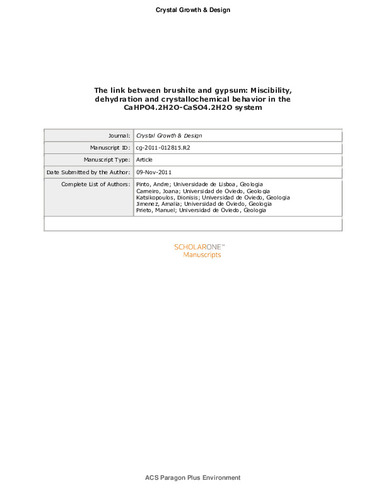The Link between Brushite and Gypsum: Miscibility, Dehydration, and Crystallochemical Behavior in the CaHPO4·2H2O−CaSO4·2H2O System
Autor(es) y otros:
Palabra(s) clave:
brusite
gypsum
miscibility
dehydration
Crystallochemical
Fecha de publicación:
Editorial:
American Chemical Society
Versión del editor:
Citación:
Descripción física:
Resumen:
The present study explores the mixing properties of the Ca(SO4,HPO4)·2H2O solid solution and the role of the “double-salt” Ca2SO4HPO4·4H2O (ardealite) by means of precipitation experiments carried out in a solution calorimeter at 25 °C. Moreover, the dehydration behavior of a number of solids with different compositions is studied by thermogravimetry and thermoX-ray diffraction. The experimental results indicate the existence of two (sulfate-rich and phosphate-rich) ranges of solid solution that are separated by two miscibility gaps from a range around the midpoint 50% molar) composition in which ardealite forms. On the phosphate-rich miscibility range, the structural (020) layers contract with the sulfate content, whereas the interlayer spacing expands. This contraction is consistent with the negative enthalpy of mixing determined from the calorimetric data. For the ardealite range of compositions, the strong contraction of the (020) layers resolves in a different stacking sequence (with double b-axis and (040) as elementary stacking layers). Therefore, ardealite is demonstrated to be not a member of the Ca(SO4,HPO4)·2H2O solid solution but a nearly stoichiometric compound with specific structural features. The thermogravimetric study indicates a specific dehydration behavior for ardealite, which again supports the idea that this phase is not a member of the solid solution.
The present study explores the mixing properties of the Ca(SO4,HPO4)·2H2O solid solution and the role of the “double-salt” Ca2SO4HPO4·4H2O (ardealite) by means of precipitation experiments carried out in a solution calorimeter at 25 °C. Moreover, the dehydration behavior of a number of solids with different compositions is studied by thermogravimetry and thermoX-ray diffraction. The experimental results indicate the existence of two (sulfate-rich and phosphate-rich) ranges of solid solution that are separated by two miscibility gaps from a range around the midpoint 50% molar) composition in which ardealite forms. On the phosphate-rich miscibility range, the structural (020) layers contract with the sulfate content, whereas the interlayer spacing expands. This contraction is consistent with the negative enthalpy of mixing determined from the calorimetric data. For the ardealite range of compositions, the strong contraction of the (020) layers resolves in a different stacking sequence (with double b-axis and (040) as elementary stacking layers). Therefore, ardealite is demonstrated to be not a member of the Ca(SO4,HPO4)·2H2O solid solution but a nearly stoichiometric compound with specific structural features. The thermogravimetric study indicates a specific dehydration behavior for ardealite, which again supports the idea that this phase is not a member of the solid solution.
DOI:
Patrocinado por:
This research was supported by the Marie Curie European Network “Mineral Nucleation and Growth Kinetics” (European Commission Grant UE-MRTN-CT- 2006- 035488) and by the Spanish Ministry of Education and Science (Grant CGL2010- 20134-CO2-02)
Colecciones
- Artículos [37354]
- Geología [544]
- Investigaciones y Documentos OpenAIRE [8231]
Ficheros en el ítem




